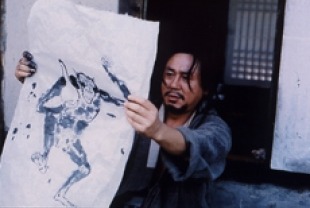Artists with their propensity for rebellion and outrageous ways of acting and creating have always provided filmmakers with very interesting material to work with. We recall the compelling movies about Vincent Van Gogh, Jackson Pollock, Caravaggio, Francis Bacon, Pablo Picasso, Camille Claudel, and Basquiat. These figures struggled with their demons and sought to express their souls with powerful and unique images. The men and women who tried to live with them and love them often found themselves playing second fiddle to the main mistress of art.
Korean director Im Kwon-Taek has fashioned a visually alluring and thematically rich portrait of Jang Seung-Ub, later known as "Ohwon," a cantankerous nineteenth century painter who broke out of all the artistic confines of his time and forged new territory that others would explore after his death. He was born into poverty and rescued by Master Kim Byung-Moon (Ahn Sung-Ki), a patron of the arts who saw in the early drawings of the boy the fire of genius.
As a young man Jang Seung-Ub (Choi Min-Sik) marches to the beat of his own artistic drummer. He stuns the nobility with a copy of an old master; he refuses to lock his drawings into requirements of the court painters or literati painters; and when he is honored with the opportunity to create for the Royal Painting Bureau, he escapes from the plush rooms where he resides for a get-together with old friends in a tavern.
Throughout his life, this artist always feels like an outsider, never able to accept his lowly origins. In one powerful scene, he stands in a violent storm and lets out a primal scream of inner agony. The artist also drinks. A cup stands near while he works on a painting with a rapt group of onlookers and musicians in the background. Jang Seung-Ub has a weakness for pretty women but is unable to sustain long relationships. The most he can offer them is a token of his creative spirit in the form of paintings. He gives one to a young admirer who dies of an illness; when he leaves another woman he has lived with for years, she asks him for something she can sell in order to survive.
"The meaning of life is to see," the seventh century Zen sage Hui Neng once noted. The true lyricism in Chi-hwa-seon is housed in Jang Seung-Ub's beguiling paintings. They are reverential in their approach to the beauty of the natural world and the transitory nature of life. Whether the subject matter is buds in bloom, the independent spirit of a hawk, or the shimmering of a goldfish, this Korean artist was able to transcend his inner feelings of unworthiness and move beyond his addiction to wine and women. He was a true connoisseur of wonder able to open the minds and hearts of others to the marvels that are bequeathed to all — rich or poor, gifted or ordinary. Although much of the material in the film is fictional, director Im Kwon-Taek remains true to the spirit of Jang Seung-Ub.
